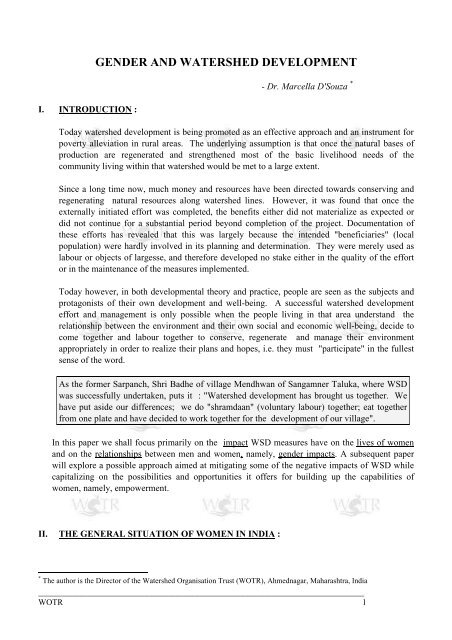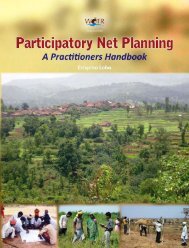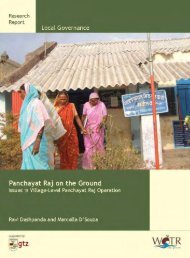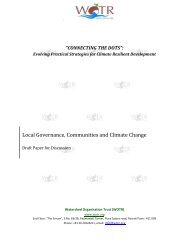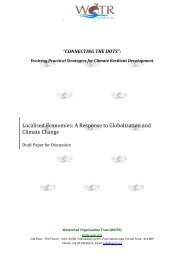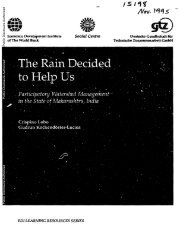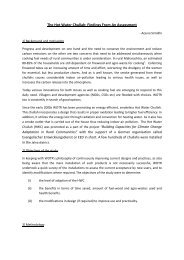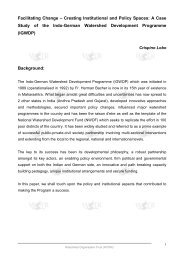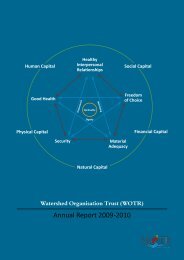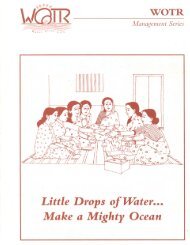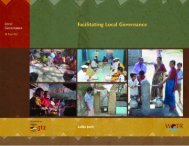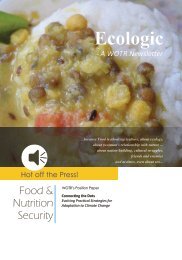GENDER AND WATERSHED DEVELOPMENT - wotr
GENDER AND WATERSHED DEVELOPMENT - wotr
GENDER AND WATERSHED DEVELOPMENT - wotr
Create successful ePaper yourself
Turn your PDF publications into a flip-book with our unique Google optimized e-Paper software.
I. INTRODUCTION :<br />
<strong>GENDER</strong> <strong>AND</strong> <strong>WATERSHED</strong> <strong>DEVELOPMENT</strong><br />
- Dr. Marcella D'Souza *<br />
Today watershed development is being promoted as an effective approach and an instrument for<br />
poverty alleviation in rural areas. The underlying assumption is that once the natural bases of<br />
production are regenerated and strengthened most of the basic livelihood needs of the<br />
community living within that watershed would be met to a large extent.<br />
Since a long time now, much money and resources have been directed towards conserving and<br />
regenerating natural resources along watershed lines. However, it was found that once the<br />
externally initiated effort was completed, the benefits either did not materialize as expected or<br />
did not continue for a substantial period beyond completion of the project. Documentation of<br />
these efforts has revealed that this was largely because the intended "beneficiaries" (local<br />
population) were hardly involved in its planning and determination. They were merely used as<br />
labour or objects of largesse, and therefore developed no stake either in the quality of the effort<br />
or in the maintenance of the measures implemented.<br />
Today however, in both developmental theory and practice, people are seen as the subjects and<br />
protagonists of their own development and well-being. A successful watershed development<br />
effort and management is only possible when the people living in that area understand the<br />
relationship between the environment and their own social and economic well-being, decide to<br />
come together and labour together to conserve, regenerate and manage their environment<br />
appropriately in order to realize their plans and hopes, i.e. they must "participate" in the fullest<br />
sense of the word.<br />
As the former Sarpanch, Shri Badhe of village Mendhwan of Sangamner Taluka, where WSD<br />
was successfully undertaken, puts it : "Watershed development has brought us together. We<br />
have put aside our differences; we do "shramdaan" (voluntary labour) together; eat together<br />
from one plate and have decided to work together for the development of our village".<br />
In this paper we shall focus primarily on the impact WSD measures have on the lives of women<br />
and on the relationships between men and women, namely, gender impacts. A subsequent paper<br />
will explore a possible approach aimed at mitigating some of the negative impacts of WSD while<br />
capitalizing on the possibilities and opportunities it offers for building up the capabilities of<br />
women, namely, empowerment.<br />
II. THE GENERAL SITUATION OF WOMEN IN INDIA :<br />
* The author is the Director of the Watershed Organisation Trust (WOTR), Ahmednagar, Maharashtra, India<br />
______________________________________________________________________________<br />
WOTR 1
The situation of women in rural India is generally characterised by hard work, both at home and<br />
on the farm, primitive hygiene conditions, poor nutritional status, little access to health and<br />
educational facilities, illiteracy and superstitiousness. They are entrusted with responsibilities of<br />
attending to the well-being of the family (nutrition, health),and are yet marginalized in matters<br />
pertaining to upbringing of children and village affairs. They possess no assets, do not have their<br />
own funds and have little access to resources.<br />
In the eyes of society the woman has a status secondary to that of man. This process has been<br />
so internalised that even in her own eyes, her identity is derived either from that of her father, her<br />
husband or her male children.<br />
III. <strong>GENDER</strong> IN <strong>WATERSHED</strong> <strong>DEVELOPMENT</strong> :<br />
Watershed development has often been described as anti-woman. It is alleged that "women's<br />
participation" means that they do the laborious work - digging of soil, raising bunds, planting<br />
trees and contributing "shramdan" (voluntary labour) while men enjoy the privilege of decision<br />
making and controlling the financial benefits.<br />
As in most programs, unless conceived by women to respond to their needs, watershed<br />
development by itself could be very gender discriminative. Moreover, since in our society it is<br />
the man who owns title to the land and who is supposed to have the aptitude and the ability to<br />
grasp technical know-how, the general tendency is that men take over watershed development as<br />
their domain of interest and influence.<br />
WHAT IS <strong>WATERSHED</strong> <strong>DEVELOPMENT</strong><br />
i) What is a Watershed ?<br />
A watershed can be defined as the drainage basin or catchment area of a<br />
particular stream or river. Simply put, it refers to the area from where the<br />
water to a particular drainage system, like a river or stream, comes from. A<br />
watershed may be small, consisting of a few hectares, or huge, covering<br />
several thousands of hectares.<br />
ii) What is watershed development and management all about ?<br />
Watershed development refers to the conservation, regeneration and the<br />
judicious use of all the resources - natural (like land, water, plants, animals)<br />
and human - within a particular watershed. Watershed management tries to<br />
bring about the best possible balance in the environment between natural<br />
resources on the one side, and man and grazing animals on the other. It<br />
requires people's participation because those who destroy it would have to<br />
want to regenerate and conserve it.<br />
iii) What are the components / sectors of watershed development ?<br />
Watershed development involves the following components / sectors :<br />
______________________________________________________________________________<br />
WOTR 2
- Human resource development (community development)<br />
- Soil and land management (conservation and use)<br />
- Water management (conservation and use)<br />
- Afforestation<br />
- Pasture (fodder) development<br />
- Agricultural development<br />
- Horticulture<br />
- Livestock management<br />
- Energy management<br />
(Ref.Guidelines on" Participation in the Indo-German Watershed Development<br />
Programme" - pg.11)<br />
Women are seen primarily as executors of decisions made by men and earners of additional<br />
income to supplement the meager family kitty. Wherever watershed development projects have<br />
been implemented it has been observed that the bulk of the labour force constitutes women (even<br />
up to 70 % in most cases), while they are hardly represented in the decision making processes<br />
relating to organization and implementation. Moreover, implementation of a successful<br />
watershed development effort involves considerable social discipline e.g. ban / control of free<br />
grazing, ban on tree felling as well as local contribution towards costs which usually takes the<br />
form of free labour (shramdan). This shramdan is largely contributed by women. The ban on<br />
free grazing and tree felling increase her workload as it is her responsibility to feed the cattle and<br />
to keep the home fires burning.<br />
It therefore appears, prima facie, that watershed development is gender discriminative.<br />
However, experiences gained from several projects have revealed a mixed picture. While there<br />
are some immediate negative effects, there are also significant benefits that accrue to women<br />
especially in the interim and long term. WSD also opens up several fora and opportunities<br />
which, if anticipated and handled sensitively, can lead to empowerment and enhancement of the<br />
status of women within their community.<br />
IV. IMPACTS OF <strong>WATERSHED</strong> <strong>DEVELOPMENT</strong> :<br />
We shall now consider some of the impacts, both positive and negative, on women and their<br />
lives as well as on gender relationships.<br />
1. THE CONTEXT<br />
In what follows, the author draws upon first hand experience obtained as well as observations<br />
made from several watershed development projects particularly those being implemented under<br />
the Indo-German Watershed Development Programme (IGWDP) in Maharashtra.<br />
The majority of the projects share the following common characteristics :<br />
______________________________________________________________________________<br />
WOTR 3
1. They are usually located in drought prone areas having an annual rainfall ranging from 150<br />
mm - 800 mm. The average rainfall of the bulk of the projects varies from 250mm. to 500<br />
mm.<br />
2. There is an acute problem of drinking water during summer.<br />
3. Hills and wastelands have sparse vegetative cover and are mainly barren and degraded..<br />
4. The geological profile is that of the Basaltic Deccan Trap.<br />
5. Agriculture is largely single cropped and rainfed.<br />
6. Crops are mainly coarse cereals.<br />
7. The watershed effort is supported by a reasonable external wage input as well as external<br />
technical expertise. The people contribute a part of the costs by way of "Shramdan".<br />
8. The project is implemented by those living within the WS, organized by a Village Watershed<br />
Committee (VWC), supported by an NGO. The VWC is a watershed level representative<br />
body that is nominated by consensus by the Gram Sabha (village body).<br />
9. A Ridge-to-valley approach is followed with emphasis on soil conservation and biomass<br />
development. Controlled grazing and ban on tree felling are enforced on treated areas.<br />
10. The watersheds generally range from 500 ha. up to 1500 ha.<br />
11. The time taken for completion of implementation measures which includes the preparatory<br />
Capacity Building Phase (CBP) is between 5.5 - 6 years. For the purpose of our analysis we<br />
shall divide this time spent into 3 periods - immediate (year 1); intermediate (years 2 - 4),<br />
and long term (year 5 onwards).<br />
2. THE BENEFITS.<br />
We shall discuss the positive impacts of WSD in treated areas under the following headings :<br />
A. Physical and Economic Impacts :<br />
i. Employment and Income<br />
ii. Food Security<br />
iii. Fodder availability<br />
iv. Fuel availability<br />
v. Savings and credit<br />
vi. Water availability<br />
B. Social Impacts -<br />
i. Migration<br />
ii. Education<br />
iii. Status and Decision Making<br />
iv. Basic Health and Hygiene<br />
______________________________________________________________________________<br />
WOTR 4
A. Physical and Economic Impacts :<br />
i) Employment and Income :<br />
A sustained effort at WSD has a notable impact on employment, income generating<br />
opportunities and length of the agricultural season.<br />
In rain-fed agricultural rural areas, except for a few months, there are hardly any work<br />
opportunities within the village. In fact, during the agricultural season too, especially in<br />
drought prone areas, the entire demand for work cannot be met in the village itself. Hence<br />
poor peasants and agricultural labourers have to go to towns or distant villages in search of<br />
work (e.g. construction sites, sugarcane cutting, digging of wells, brick kilns etc.). With wage<br />
supported watershed activities starting in the watershed, the people, especially women, avail of<br />
this opportunity to enhance the family funds . This has a direct bearing on the family welfare<br />
and stability.<br />
Afforestation and pasture development require a large amount of planting material (saplings<br />
and grass seeds). In order to meet this need, nurseries are usually developed in situ wherever<br />
water is available. This is an activity that is most frequently associated with women. In<br />
addition to generating substantial income, nursery raising equips women with skills and<br />
knowledge which are an asset. Women can and do avail of this opportunity to decide what<br />
saplings are to be grown to meet their needs. From the fifth year onwards horticultural<br />
operations enhance employment opportunities available to women.<br />
Similarly with an increase in soil moisture as well as increased availability of water, the<br />
agricultural season lengthens specially from the third year onwards. Agriculture labour<br />
opportunities, earlier limited, are now available for a longer period within the village itself.<br />
Depending on circumstances as well as markets, agro-based allied income generating activities<br />
like dairy, stall fed goat rearing, poultry etc. can also be undertaken particularly from the third<br />
and fourth years.<br />
ii) Food Security<br />
With a reasonable wage obtained on a regular basis as a result of watershed activities (WSA),<br />
the family acquires additional purchasing power to augment the food intake.<br />
In a tribal village Khodpakhindi of Yavatmal District, prior to WSD, the<br />
family diet in general consisted mainly of jowar. They could afford to have<br />
meat once a month or during feast days only. Today, two and a half years<br />
after the project started, their diet has improved. Besides jowar they regularly<br />
have wheat, vegetables and oil. Now they also have meat at least once a<br />
week.<br />
With soil conservation measures and extension support, land and agricultural productivity<br />
increases from the second or third year itself. Farm production increases in terms of both food<br />
crops and farm products (e.g. eggs, chicken, dairy products, etc.). When this is coupled with<br />
______________________________________________________________________________<br />
WOTR 5
information and inputs on nutrition and nutrition oriented agricultural practices, e.g. kitchen<br />
gardens, appropriate food crops etc. the nutritional status of the family and village is<br />
progressively improved. Food security is thus a direct consequence of watershed activities and<br />
provides the foundation for enhancement of nutritional status provided the latter is specially<br />
addressed..<br />
iii) Fodder Availability :<br />
Obtaining fodder is largely the responsibility of women. Fodder and forage is obtained either<br />
from farm lands or Common Property Resources (CPR) i.e. village owned lands as well as<br />
government/forest lands accessible to villagers or private wastelands or from outside the<br />
watershed.<br />
Largely due to indiscriminate grazing and poor quality of grasses there is an acute lack of<br />
sufficient and nourishing fodder available throughout the year. This does not allow for the<br />
rearing of high yielding productive animals . However, when free grazing is banned on CPR,<br />
or private wastelands & pasture enhancement measures are undertaken, good regeneration of<br />
naturally occurring grasses as well as establishment of improved nutritious varieties occur in<br />
abundance. Then women will not be required to go long distances in search of fodder.<br />
Moreover, as the agricultural season lengthens and productivity increases, the agricultural<br />
residues also increase. This, in fact, is usually evident from the third year of project<br />
implementation onwards.<br />
Wherever there is surplus fodder, the same can be sold, which further adds to the income. The<br />
above is usually evident from the second year onwards.<br />
Khodpakhindi village of Nanded District, in the second year of project implementation, harvested<br />
and stored sufficient grass to meet the fodder needs of every family of the village for the entire<br />
summer season, even though the watershed was only partially treated.<br />
It has been observed that the increase in the fodder stock results not only in additional<br />
livestock maintaining capacity, but also the rearing of high yielding productive cattle and<br />
livestock.<br />
Dongaon village of Nanded District, in the third year of the project, harvested 2,50,000<br />
bundles of grass. The village has now taken bank loans and purchased<br />
35 cross-bred cows.<br />
In case the family does not have adequate amount of fodder, this can now be purchased from<br />
within or outside the watershed from the wage income obtained due to work available in the<br />
watershed as well as due to increased earnings from agriculture.<br />
By the end of the third year of project implementation, the number of cross-bred cattle<br />
had increased substantially in village Mendhwan. Fodder requirements outstripped what<br />
was locally available and had to be met from external purchases. The villagers leased in<br />
grasslands from a watershed 45 km away which had a better rainfall and soil regime.<br />
______________________________________________________________________________<br />
WOTR 6
iv) Fuel availability :<br />
With the environment bare and degraded, the woman has to go long distances to obtain good<br />
firewood, failing which she has to take recourse to thorny bushes, brambles and other poor<br />
quality fuel material. The search for fuel is her constant preoccupation. Much of her time and<br />
energy is utilized to keep the home fires burning. Moreover whenever WSD activities are<br />
seriously undertaken a ban on tree felling is usually enforced.<br />
Now, however, with additional income from wages from the first year itself she is able to<br />
augment her fuel stock by external purchase of wood or kerosene. Moreover, as a result of<br />
increased agricultural output, agricultural wastes are now increased from the second or third<br />
year itself. From year 5 - 6 onwards, as a result of afforestation and natural regeneration of<br />
root stock on both CRP and private wastelands, biomass by way of firewood, twigs and<br />
loppings augments fuel availability.<br />
v) Savings and credit :<br />
Women hardly have any savings and therefore in times of need have to borrow from the money<br />
lenders who charge exorbitant rates of even 100 % or more per annum.. In the case of<br />
sugarcane-cutting migrants the entire family is, as it were, "bonded" for the following season<br />
due to the "timely" financial aid given by the contractors.<br />
When women are motivated to form savings and credit groups, the money earned from wages<br />
and other activities can easily be used to generate initial funds for internal lending and<br />
utilization. This not only makes credit on demand available at reasonable rates, but also<br />
strengthens the bonds among the women in the village which empowers them. This begins<br />
within the first year itself.<br />
In Nandkheda village of Jalna District, the capacity building phase of the project began in<br />
November ' 95. Because of motivation by the NGO, 60 women started savings by January<br />
'96. Their savings and credit groups function well today. The number of women in the<br />
savings groups have increased and their savings amount<br />
to Rs. 13,600/. as on the 1st. March 1997.<br />
Usually banks do not like dealing individually with petty account holders because of high<br />
transaction costs. However, if the savings groups generate substantial sums of money, these<br />
become attractive and women can then, as a group, access banking facilities. This is already<br />
possible from the third year onwards.<br />
vi) Water availability :<br />
The search for potable water specially in summer, breaks the backs of women who have to<br />
trudge long distances and spend several hours each day to get water which is often unfit for<br />
consumption. In drought prone areas, tankers with drinking water come once in two days<br />
during the months of February to August, depending on the rains.<br />
However, from the second year itself, in treated areas which have experienced a reasonable<br />
monsoon there is an appreciable increase in the ground water table which is reflected in an<br />
______________________________________________________________________________<br />
WOTR 7
increased water level in the village wells. Clean drinking water is now available as well as<br />
water for protective irrigation. This has considerable impact not only on agriculture but also<br />
and particularly so on the quality of life and health of women and the family. Her anxiety and<br />
work load are now reduced to a considerable extent.<br />
In village Mendhwan, district Ahmednagar, prior to 1993, every year during the months of<br />
April to end August, tankers of drinking water were brought twice daily to the village. In<br />
June 1996, despite 3 consecutive years of drought (rainfall of 170-200 mm driking water<br />
was still available in the village and no takers were required.<br />
B. Social Impacts :<br />
Participatory Watershed Development (PWSD) has a definite impact on the social situation and<br />
offers a variety of opportunities. Some impacts are a direct consequence of Watershed Activities<br />
(WSA), e.g. stoppage / reduction of migration. Others occur only if considerable efforts are made<br />
by way of social engineering towards achieving the desired objectives, such as improvement in the<br />
educational status of the girl child as well as the woman herself, health and hygiene and also<br />
increased involvement of women in decisions concerning land use and other organisational<br />
matters.<br />
i. Migration :<br />
Usually after the agricultural season is over, a large number of families migrate in search of<br />
work. This has serious consequences on the education of the children as well as on the<br />
quality of life of the family. Now, with work being undertaken on a sustained basis within<br />
their own watershed and which is adequately remunerated, migration is either immediately<br />
or progressively reduced. This latter usually results due to earlier contractual obligations<br />
.However by the third year migration stops almost completely.<br />
As Ratanbai of Dongaon relates : "Formerly half of the population would migrate by the<br />
month of December. This is now stopped because watershed development work is available<br />
throughout the year. Even the harvesting of grass provides employment opportunities. Now<br />
people do not migrate".<br />
ii. Education :<br />
Stoppage of migration provides a situation of stability. It has been observed in several<br />
watersheds that this results in an increase in the number of school-going children and an<br />
increase in the schooling period. Parents now send their children to school since they do not<br />
migrate for work. Besides, they can afford it as they are now earning sufficiently from project<br />
measures to do without the income- augmenting activities which children undertake, such as<br />
sheep and live-stock herding Furthermore, once the ban on free grazing and enclosure takes<br />
effect, free roaming cattle are reduced and replaced by high yielding intensively managed<br />
livestock. Normally, unless there is protracted drought, the returns thereof are substantially<br />
higher than those obtained from herding. Thus children are enabled to continue their<br />
education.<br />
______________________________________________________________________________<br />
WOTR 8
The impact on the education of children is best noted among the tribal groups.<br />
Pimpaldhara is a tribal hamlet of the Bhojdari Watershed consisting of about 25 families.<br />
Three years ago, prior to the initiation of the project, not a single child registered in the<br />
village school. Today 15 children ( about 50% ) now regularly attend primary school.<br />
Whenever encouraged and facilitated, women have also expressed a desire to be made literate<br />
and informed on various matters affecting their lives.<br />
Both the above two impacts have been observed from the second year itself.<br />
iii. Status and Decision Making :<br />
Wage supported WS measures enable women to acquire their own funds. The regular cash<br />
income thus earned enhances their status in their own eyes as well as in that of the family and<br />
society. It gives them a sense of security. This has an impact on gender relationships. It has<br />
been observed that women gradually gain self- confidence and self-respect.<br />
Participatory WSD (PWSD) necessarily involves organisational processes and mechanisms<br />
and as such offers a number of opportunities for women . As most of the effects of WSD have<br />
an impact on women's daily chores such as fuel and fodder availability, water and food<br />
security it would be very beneficial, nay, important, that women participate actively in<br />
decisions concerning land use, types of trees to be planted as also in other organizational<br />
matters.<br />
Sunanda of the Darewadi WSDP emphasised the importance of woman's participation<br />
together with their husbands in land use planning ( LUP) when she said, "Men think in<br />
terms of crops that fetch money; but we women would like crops that meet the household's<br />
food requirements first while the rest of the land may be used for cash crops".<br />
Wherever men leaders have been encouraged and nudged to give greater space to women -<br />
and this is possible since women contribute the bulk of the labour force (60 - 70 % on an<br />
average), earn a regular income and are responsible for about 70% of farm chores - women<br />
gradually and non-conflictually are being inserted into the institutional decision making<br />
mechanisms of the village and the watershed development effort. It has been observed that<br />
women acquire a greater status in society, respectability , more self-confidence and a greater<br />
say in matters concerning the family. While these changes are not drastic, they are nevertheless<br />
perceptible from the third year onwards as is evident judging from the way women interact<br />
amongst themselves, with their men-folk and often in the articulation of their hopes and<br />
dreams for their children and family.<br />
iv. Basic Health and Hygiene :<br />
This is a direct consequence of enhanced nutrition, access to clean drinking water, improved<br />
living conditions, basic knowledge of promotive health and prevention of diseases and access<br />
to basic facilities.<br />
______________________________________________________________________________<br />
WOTR 9
Watershed development results in increased availability of clean drinking water, food security,<br />
as well as increased income from enhanced agricultural productivity, allied activities as well as<br />
wages. If this is coupled with inputs on promotive health and prevention of diseases, together<br />
with access to health facilities made possible due to increased income, a definite improvement<br />
in the health and hygiene conditions is possible especially from the third year onwards.<br />
It has been observed that in several villages where such inputs were given, the number of<br />
women visiting medical practitioners as well as the frequency of visits has increased<br />
considerably. Minor aliments which were ignored earlier are now attended to.<br />
______________________________________________________________________________<br />
WOTR 10
We shall now present schematically the beneficial impacts on women and gender relationships<br />
as discussed above.<br />
Table I: WOMEN <strong>AND</strong> <strong>WATERSHED</strong> <strong>DEVELOPMENT</strong>: IMPACT ON KEY INDICATORS &<br />
TIME FRAMES<br />
P E R I O D<br />
INDICATORS Immediate Intermediate Long-term<br />
A) Physical and Economic Impacts<br />
1) Availability of Income opportunities :<br />
a. Work Opportunities<br />
i. On Site (WSD *1 )<br />
ii. Nursery raising<br />
iii. Fields (Agri.)own and others<br />
iv. Horticulture<br />
b. Allied Activities<br />
i. Poultry<br />
ii. Dairy<br />
iii. Stall fed Goat rearing<br />
iv. Fisheries<br />
v. Non-farm activities<br />
2) Food Security<br />
a. External purchases<br />
b. Own farm production<br />
c. Kitchen Gardens<br />
3) Fodder availability<br />
a. Agricultural residues<br />
b. Common Property resources '2<br />
c. External purchases<br />
d. Private wastelands<br />
4) Fuel availability<br />
a. External Purchases<br />
b. Own farm *3<br />
c. CRP<br />
5) Savings and Credit<br />
a. Internal generation and<br />
circulation (village level)<br />
b. Access to banking system<br />
6) Water availability for households and<br />
farming<br />
Year 1 Year 2 Year 3 Year 4 Year 5 onwards<br />
*-----------<br />
*-----------<br />
*-----------<br />
*-------<br />
---------<br />
*--------<br />
______________________________________________________________________________<br />
WOTR 11<br />
*---<br />
----------<br />
*---<br />
*--------<br />
----------<br />
---------<br />
-----------<br />
-----------<br />
-----------<br />
*---------<br />
*---------<br />
-----------<br />
-----------<br />
-----------<br />
*---------<br />
*---------<br />
*---------<br />
*---------<br />
-----------<br />
*---------<br />
-----------<br />
*---------<br />
-----------<br />
-----------<br />
-----------<br />
-----------<br />
-----------<br />
*----------<br />
*----------<br />
*----------<br />
-----------<br />
-----------<br />
-----------<br />
-----------<br />
-----------<br />
-----------<br />
-----------<br />
-----------<br />
-----------<br />
-----------<br />
-----------<br />
-------->|<br />
--------------- ><br />
--------------- ><br />
*--------------><br />
--------------- ><br />
---------------><br />
--------------- ><br />
--------------- ><br />
--------------- ><br />
--------------- ><br />
--------------- ><br />
--------------- ><br />
--------------- ><br />
--------------- ><br />
--------------- ><br />
--------------- ><br />
--------------- ><br />
--------------- ><br />
*--------><br />
---------------><br />
--------------- ><br />
--- ----------- ----------- --------------- ><br />
*1 WSD - Watershed Development<br />
'2 CRP - Comman Property Resources : Village owned lands, Government owned lands which are made accessible to the villagers<br />
*3 Agricultural residues
B) Social Impacts *4<br />
P E R I O D<br />
INDICATORS Immediate Intermediate Long-term<br />
1) Stoppage of Migration *5<br />
2) Improvement in women's status<br />
(participation in land use decisions, in<br />
VWC *6 meetings and Gram<br />
Sabhas *7 )<br />
3) Educational Status<br />
a. Women<br />
b. Children<br />
Year 1 Year 2 Year 3 Year 4 Year 5 onwards<br />
* - - -<br />
- - - - - -<br />
-----------<br />
-----------<br />
*7 ______________________________________________________________________________<br />
Gram Sabha - Village Meeting<br />
WOTR 12<br />
*----<br />
*----<br />
--------------- ><br />
*--------- ----------- --------------- ><br />
----------<br />
----------<br />
-----------<br />
-----------<br />
--------------- ><br />
--------------- ><br />
4) Health and Hygiene *--------- ----------- --------------- ><br />
*4 The social impacts other than stoppage of migration do not occur automatically. They depend crucially<br />
on a vriety of factors as also the management input of the NGO.<br />
*5 Migration begins to taper off and stops by the 3rd year of project activities.<br />
*6 VWC - Village Watershed Committee
3. THE NEGATIVE EFFECTS ON WOMEN :<br />
While women do benefit from watershed development, their work load, as well as<br />
hardships nevertheless increase considerably. Moreover, since successful watershed<br />
development necessarily involves the participation of all groups in the village, should<br />
conflicts arise, and the project stops, this group, namely, women, would be hardest hit.<br />
This group constitutes the majority of the labour force and puts up with the greatest<br />
amount of hardships resulting from adhering to the socio-cultural discipline involved in<br />
successful participatory watershed development (e.g. ban on free grazing, tree felling<br />
etc.). This therefore is the most vulnerable section of society and suffers from<br />
considerable stress and insecurity.<br />
A. Economic Impacts :<br />
1) Employment and Income Opportunities :<br />
a. A woman's need for money and the availability of work in the village itself encourages<br />
her to put in about 7 - 8 hours per day at the watershed site, besides the usual house<br />
work. Her working hours/day then usually become 16 - 18 hours. Thus she does not<br />
have time for relaxation or her own education. Besides she cannot give her children<br />
the time they need.<br />
b. With watershed development, agricultural productivity increases. With about 70 % of<br />
the farm activities being done by women ,specially the laborious and non-mechanised<br />
works, her work load now increases. For instance, when 1 crop is harvested per year,<br />
at least 3 months of women's labour is required: now with the possibility of a second<br />
crop, 6-8 months of women's labour is demanded. Thus increase in agricultural<br />
productivity leads to an increase in the work load especially of the tedious kind.<br />
c. With the increase in the availability of fodder as well as water, people feed<br />
emboldened to undertake agro-based and allied activities such as animal husbandry<br />
and the processing of agro products. Usually it is the women who work hard at the<br />
caring, feeding and cleaning of the animals and the sheds. Furthermore, processing of<br />
agro products is usually done by them. However, the marketing of milk and other<br />
produce is controlled by men. So, while the labour is the women's, the control of the<br />
income is the men's. Thus gender inequities are further endorsed and perpetuated.<br />
2) Food :<br />
a. It is normally the man who decides what crops are to be grown on the farm. Wherever<br />
there is increase in the availability of water, farmers tend to go in for cash crops<br />
instead of food production. In addition to increasing the work load of women, the real<br />
danger is that food and nutritional requirement of the family may not be adequately<br />
met from home production. This has happened in the case of the successful<br />
cooperative dairy industry in India.<br />
______________________________________________________________________________<br />
WOTR 13
. In such circumstances, where household requirements are not met by one's own farm<br />
production, the same would have to be purchased from others or from urban centres.<br />
This leads to a depletion of the household savings and outflow of village income to<br />
urban areas. These purchases are normally done by the women from the money they<br />
earn, thus resulting in a decline in their financial position.<br />
3) Fodder :<br />
a. With the ban on free grazing, it is usually the poor, and that too poor women, who are<br />
often forced to graze their animals outside the watershed or pay compensation for<br />
grazed plants. This often involves considerable travel, conflicts with competing<br />
grazers or pasture owners and economic hardships. Often they would even have to<br />
sell their animals either due to social pressure or if the fodder requirements cannot be<br />
met as was the experience of Dongaon.<br />
In the WS of Dongaon, in the first years of project implementation, villagers had to<br />
sell off large herds of local cattle and goats primarily due to closure of pasture<br />
grounds. The same experience has also been observed in other villages.<br />
b. Furthermore, with introduction of stall feeding and cut-and-carry methods of fodder<br />
access, hardships to women increase, as it is often the women who get the fodder and<br />
not the men. This is specially true of small holders. The fodder grounds would<br />
usually be about 0.5 - 1 km away from the habitations as they are usually located in<br />
the forest and revenue waste lands which border the villages.<br />
4) Fuel :<br />
a. It is the man who usually decides on what species of trees are to be planted and he will<br />
normally go in for "productive trees" (timber & fruit producing, implement making<br />
etc.) rather than trees that could also respond to women's needs (e.g. fuel, fodder trees<br />
etc.). Women's preferences are often given the go-by.<br />
In village Nandora, initially the decision regarding the selection of plant species<br />
was in the hands of the men who raised only one economic variety, namely teak.<br />
However when women took over the nursery, they raised fuel, fodder and fruit<br />
species namely zyzyphus, bamboo, awla, bor, sitaphal, bihada etc. One of the<br />
women described her feelings thus," Now the nursery meets our needs".<br />
b. The responsibility of keeping the family stove burning rests on women. With the ban<br />
on tree felling, which is often wrongly interpreted as ban on loppings, she often has to<br />
walk long distances, even outside the village, to get firewood. To augment her fuel<br />
stock, valuable agricultural residues and dung are also burnt.<br />
______________________________________________________________________________<br />
WOTR 14
5) Savings and Credit :<br />
Usually the basic survival needs of a family are met mostly from the money women<br />
earn and save. It is often the experience that they have little control over their hard<br />
earned income and savings. Men impound it for purchase of assets which are owned<br />
by them, or for their own needs and at times even for wasteful purposes e.g. gambling<br />
and drinking.<br />
Moreover it is observed that when women have access to credit either through their<br />
own SHGs or banks, their men folk tend to pressurize them to take loans for their own<br />
purposes.<br />
In village Jondhlewadi, some men pressurized their wives who were members of a<br />
women's credit group to demand its liquidation so that they could get immediate<br />
lumpsum possession of the money that was due to them.<br />
6) Water Availability :<br />
With increase in water availability the tendency of farmers is to increase the area<br />
under cultivation. Moreover, there is a tendency to go in for high value water<br />
consumptive crops, e.g. sugarcane, grapes. If this is done unrestrainedly, the ground<br />
water level gets rapidly depleted and the water situation quickly returns to the preproject<br />
stage. Adequate potable water within a reasonable distance from the home and<br />
water for livestock are the first casualties.<br />
Unless special care is exercised those who have access to resources can quickly<br />
exploit augmented ground water reserves . Thus a limited few would capture a major<br />
share of benefits. The losers are the rain dependent farmers especially the small ones.<br />
This leads to the surfacing of a new power elite (which might also include some or all<br />
of the elements of the existing ones) who take over decision making institutions,<br />
purchase additional lands and are generally conservative and acquisitive. This would<br />
then result in an increase in the number of landless, greater immiserization and<br />
marginalization of the small rain-fed farmer. The consequence is increased hardships<br />
to women.<br />
B. Social Impacts :<br />
1) Education :<br />
While women do want to improve their educational and knowledge levels, the long<br />
working days (16-18 hours) leaves them too tired and exhausted to really concentrate<br />
on the acquisition of skills and knowledge. Thus even if they do have disposable<br />
income, they are disadvantaged vis-a-vis men who, in a similar situation, generally<br />
enjoy some leisure and are able to travel and be exposed to a variety of learning and<br />
enabling opportunities.<br />
______________________________________________________________________________<br />
WOTR 15
During periods of drought when disposable income declines sharply, girls are the first<br />
to be withdrawn from school.<br />
2) Status and Decision Making :<br />
The process of integrating women into the dynamics and politics of village level<br />
projects and institutions is by no means simple nor can be assumed. Access to income<br />
and own funds can also be a source of tension and discord within a family if the men<br />
folk feel threatened.<br />
In Kadus Watershed, payment of wages is accompanied by a memo outlining<br />
details. Some women requested that wages due to them for work done be paid to<br />
them in 2 parts with 2 separate memos - one in their own name and the other in the<br />
name of another person, usually their married daughter or a relative living outside<br />
the village, in whom they have confidence. They would hand over to their husbands<br />
their "own" memo and wages and keep the other memo and wages to themselves.<br />
This they saved or invested to meet the needs of the family in times of crisis or to<br />
give useful gifts to their married daughters when they visited.<br />
If gender related issues are not handled sensitively, appropriately and with patience,<br />
there could be a backlash which may result in greater marginalisation and oppression<br />
of women.<br />
Furthermore, due to internalization of cultural restrictions and practices, women find it<br />
difficult to openly and clearly state their expectations and points of view. Often, they<br />
echo the views of their men-folk thus immediately reaffirming their current situation<br />
of "obedient wives" , "handmaids" to their men.<br />
3) Basic Health and Hygiene :<br />
As is the common trend in villages, boys are given preference in both education and<br />
nutrition vis-a-vis girls. With an increase in disposable income and food availability,<br />
while the absolute quantum available to both increases, boys gain relatively far more<br />
than girls. Thus, girls lose out relatively, health-wise, physically and educationally.<br />
During periods of protracted drought, or when food is in short supply, girls are the first<br />
victims. Not only is their nutritional intake reduced relative to their male siblings, their<br />
health problems also are attended to much later than that of their male counterparts.<br />
______________________________________________________________________________<br />
WOTR 16
V. WOMEN'S REACTION :<br />
In my interaction with women, I have observed that despite the limitations and hardships<br />
mentioned above, women nevertheless are willing to accept the extra work load as well as<br />
the hardships for 3 primary reasons :<br />
(1) They want to have access to a steady flow of income in order to enjoy food and<br />
financial security especially for times of crises e.g. if abandoned by their husbands or<br />
widowed.<br />
(2) They want to ensure the future of their children by sending them to school, because<br />
they realise that unless their children get educated, their lives would be as filled with<br />
hardships as their own, if not more so.<br />
(3) They want to participate in decision making at home (utilisation of funds, upbringing<br />
of children, land use and village affairs) and thus be accepted and respected by<br />
society.<br />
In order, however, to lighten their burden and also ensure that their hopes are realized,<br />
they have expressed the need for the following :<br />
(i) training programs, opportunities for study (non-formal classes) and exposure visits so<br />
as to broaden their horizons and improve their skills. Such visits also serve the<br />
purpose of socialisation and relaxation.<br />
(ii) day care centres for children which would not only provide quality care for their<br />
children but also free the parents for work.<br />
(iii) Drudgery reducing alternatives e.g. by the use of alternate improved energy sources,<br />
potable water sources, functioning and efficient pumps close to their homes,<br />
availability of better fuel like kerosene, better agricultural implements etc.<br />
(iv) the possibility of saving securely as well as the availability of loans as and when<br />
required and without much bureaucracy.<br />
(v) access to health and hygiene facilities since nutritional deficiencies, intestinal<br />
infections and other preventable diseases are a major cause of fatigue and debility<br />
which affects intellectual and physical productivity as well as acts as a drain on their<br />
meager income.<br />
(vi) reasonable assurance of a steady income through other income generating projects<br />
even after the watershed development project is completed.<br />
______________________________________________________________________________<br />
WOTR 17
Thus, I have observed that there is a strong desire on the part of women to acquire a sense<br />
of identity which would be accepted by society and to move from creaturehood to<br />
personhood.<br />
Where such a possiblity exists, women are willing to accept the hardships involved.<br />
VI. CONCLUSION :<br />
Watershed Development by itself is not gender discriminative. It is the socio-economic<br />
and cultural framework existing within a particular watershed that determines gender<br />
relationships and discrimination. In the rural agrarian setting in India this framework is<br />
definitely biased against women.<br />
In such a system, any external infusion of resources (finance and technology) with no<br />
reference to the underlying transfer and power mechanisms will necessarily strengthen<br />
existing inequalities and biases.<br />
Hence, if a particular initiative is not to become gender discriminative, thought must be<br />
paid not only to the "control" and the "delivery mechanism" but also to the "distributive"<br />
effect and mechanism.<br />
Participatory Watershed Development, wherein space is created for women's active<br />
involvement, not only addresses the core concerns of women, but also offers them the<br />
possibility to get integrated into the socio-economic-political life as also the decision<br />
making processes and institutions of the village and also matters pertaining to the family.<br />
Thus Participatory Watershed Development, which plans and allows for women's<br />
empowerment can discriminate in favour of women especially in the interim and long run<br />
even though initially, and for a time thereafter, women are saddled with additional chores,<br />
burdens and responsibilities.<br />
---- xxx----<br />
______________________________________________________________________________<br />
WOTR 18


